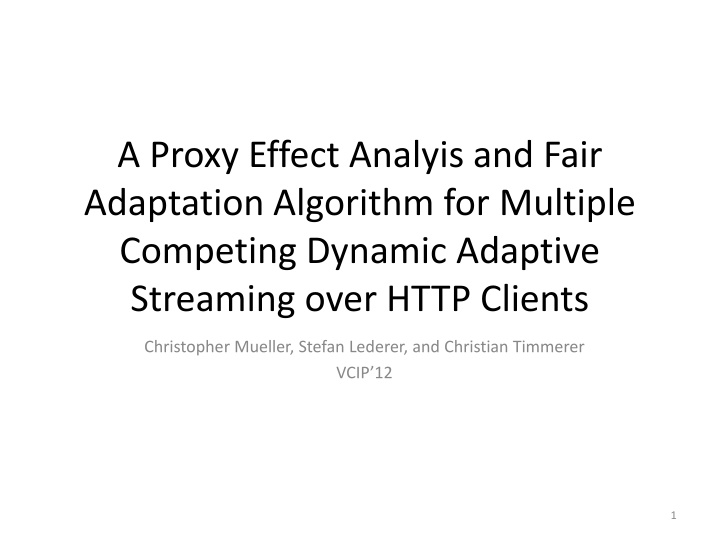Proxy Effects and Fair Adaptation for Dynamic Adaptive Streaming
This study focuses on the implementation of a proxy effect analysis and fair adaptation algorithm for managing multiple competing dynamic adaptive streaming over HTTP clients. By considering factors like client awareness, network structure, and adaptation decisions, the algorithm aims to mitigate negative effects resulting from client competition for bandwidth. Through experiments using Big Buck Bunny as content, the research explores metrics such as average bitrate, quality switches, and buffer levels to evaluate the effectiveness of the proposed approach.
Download Presentation

Please find below an Image/Link to download the presentation.
The content on the website is provided AS IS for your information and personal use only. It may not be sold, licensed, or shared on other websites without obtaining consent from the author.If you encounter any issues during the download, it is possible that the publisher has removed the file from their server.
You are allowed to download the files provided on this website for personal or commercial use, subject to the condition that they are used lawfully. All files are the property of their respective owners.
The content on the website is provided AS IS for your information and personal use only. It may not be sold, licensed, or shared on other websites without obtaining consent from the author.
E N D
Presentation Transcript
A Proxy Effect Analyis and Fair Adaptation Algorithm for Multiple Competing Dynamic Adaptive Streaming over HTTP Clients Christopher Mueller, Stefan Lederer, and Christian Timmerer VCIP 12 1
Introduction DASH or DASH-like Streaming logic is located at the client Multiple version of the content Logic is located ate the client clients are not aware of each other and the network infrastructure Negative effects when clients are competing for a bottleneck Wrong adaptation decision 2
DASH-based Proxy Effects Base quality bitrate: 5 Mbps Enhancement quality bitrate: 7 Mbps 3
DASH-based Proxy Effects (cont.) Client 1 start the streaming slightly before client 2 Base quality be cached on the proxy Client 2 try to adapt to the maximal available bandwidth Proxy has to maintain two connections to content server Base quality and enhancement quality Assume connections in a fair way 4
Fair Adaptation For simplicity, set and to 1 probe(): identify the effective available bandwidth for next segment 5
Experiments Content: Big Buck Bunny Video codec: X264 GOP: 48 frames Length: 2 sec. Metrics: Average bitrate Number of quality switches Buffer level 6
Experiments (cont.) Big Buck Bunny at 700 kbps and 1300 kbps 7
Experiments (cont.) Microsoft Smooth Streaming Server: Microsoft Windows Server 2008 Client: Windows 7 with Sliverlight 5 MPEG-DASH Server: Ubuntu 10.04 Apache Client: VLC media player 8
Microsoft Smooth Streaming Adaptation process 9
Microsoft Smooth Streaming (cont.) Buffer fill status 10
MPEG-DASH 1000 Kbps 1700 Kbps 1700 Kbps 1700 Kbps 11
MPEG-DASH (cont.) More frequently at client 2 12
MPEG-DASH (cont.) Client 2 has an unsmooth playback at second 20 13
MPEG-DASH with Fair Adaptation Eliminate frequent switching effect at Client 2 14
MPEG-DASH with Fair Adaptation (cont.) Both clients are maintaining a more stable buffer 15
Conclusion Described negative effects that could occur when multiple DASH clients are competing for a bottleneck. Evaluation of major industry solutions and our own fair adaptation logic under dynamic bandwidth conditions. 16























